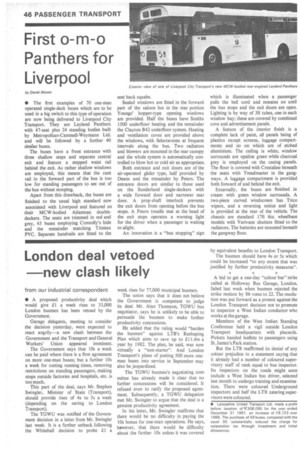First o-m-o Panthers for
Page 48

If you've noticed an error in this article please click here to report it so we can fix it.
Liverpool Exterior view of one of Liverpool City Transport's new MCW-bodied rear-engined Leyland Panthers
by Derek Moses
• The first examples of 70 one-man operated single-deck buses which are to be used in a big switch to this type of operation are now being delivered to Liverpool City Transport. They are Leyland Panthers with 47-seat plus 24 standing bodies built by Metropolitan-Cammell-Weymann Ltd. and will be followed by a further 40 similar buses.
The buses have a front entrance with three shallow steps and separate central exit and feature a stepped waist rail behind the exit. As rather shallow windows are employed, this means that the cant rail in the forward part of the bus is too low for standing passengers to see out of the bus without stooping.
Apart from this drawback, the buses are finished to the usual high standard now associated with Liverpool and featured on their MCW-bodied Atlantean doubledeckers. The seats are trimmed in red and grey, 45 buses employing Connolly's hide and the remainder matching Trimtex PVC. Separate handrails are fitted to the seat back squabs.
Sealed windows are fitted in the forward part of the saloon but in the rear portion Youngs' hopper-type opening windows are provided. Half the buses have Smiths 1500 underfloor heating and the remainder the Clayton B42 underfloor system. Heating and ventilation coves are provided above the windows, with Selectavents at frequent intervals along the bus. Two radiators and blowers are mounted in the rear canopy and the whole system is automatically controlled to blow hot or cold air as appropriate.
Both entrance and exit doors are of the air-operated glider type, half provided by Deans and the remainder by Peters. The entrance doors are similar to those used on the Sunderland single-deckers with a wide forward door and narrower rear door. A prop-shaft interlock prevents the exit doors from opening before the bus stops. A Peters treadle mat at the head of the exit steps operates a warning light for the driver when a passenger is waiting to alight.
An innovation is a "bus stopping" sign which is illuminated when a passenger pulls the bell cord and remains on until the bus stops and the exit doors are open. Lighting is by way of 3ft tubes, one in each window bay; these are covered by combined cove and advertisement panels.
A feature of the interior finish is a complete lack of paint, all panels being of plastics except screens, luggage compartments and So on which are of etched aluminium. The ceiling is white, window surrounds are opaline green while charcoal grey is employed on the casing panels. The floor is covered with Crestaline beneath the seats with Treadmaster in the gangways. A luggage compartment is provided both forward of and behind the exit.
Externally, the buses are finished in cream with green window surrounds. A two-piece curved windscreen has Trice wipers, and a reversing notice and light is provided at the rear of the vehicle. The chassis are standard 17ft 6in. wheelbase models with Varivane shutters fitted to the radiators. The batteries are mounted beneath the gangway floor.








































































































































